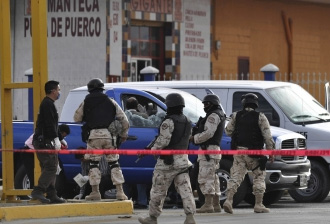America's Third War: Tracking Cocaine, One Kilo at a Time
 William La Jeunesse - Fox News William La Jeunesse - Fox News
go to original
December 09, 2010


| | Soldiers patrol as forensics stand next to a truck where two investigative police officers were shot by unidentified assailants in Ciudad Juarez, Mexico, Monday Dec. 6, 2010. One investigative police officer died in the shooting, according to police. |  |
It’s Mexico’s war, but Americans pay for it. Blame the violence, chaos, murder rate, corruption, instability and innocent lives taken – not on Mexico – but on America's drug habit, says Jim Gray, a former California Superior Court Judge and Los Angeles County prosecutor.

“That’s our drug money that’s doing it and we should be ashamed of ourselves because we’re the ones that arrogantly look at Mexico and tell them, ‘you should do more to resolve your drug problem,’ and that’s stupid,” said Gray.

Most of the heroin, methamphetamine, marijuana and cocaine consumed in the U.S. originates in, or transits through Mexico.

“Anyone that is buying narcotics is financing that effort,” said Chief Paul Beeson, head of San Diego sector of the U.S. Border Patrol.

The U.S.-Mexican border is but one hurdle for the cartels, one step in a long, but profitable journey that fuels the violence in Mexico.

Consider the profits on a single kilogram of cocaine, or about 2.2 pounds.

Cocaine originates from a coca plant, typically grow in in Peru, Bolivia or Colombia. The price to a local farmer is about $1,000 a kilo.

Flown to Columbia as a dull brown coca paste, the kilo doubles in price when it’s processed into cocaine powder.

From there, the colorful, plastic-wrapped cocaine packages travel by plane, truck or submarine to Mexico, where the price jumps to $10,000 a kilo.

Now the difficult leg - crossing over or under the U.S. Border. Stuffed in car tires, smuggled on the backs of illegal immigrants, flown by ultra-light aircraft, driven in vans, swallowed in rubber condoms – cocaine that arrives north of the fence triples in value to $30,000 a kilo and higher.

Why so creative and desperate?

“The money gets the cartels additional narcotics, it gets them transportation cells, it gets them weapons, it gets them information,” said Beeson. “Those profits pay for corruption.”

Once it arrives in the U.S., the cocaine is distributed to street gangs, who cut it with additives to reduce the purity and stretch their investment. When sold to U.S. consumers by the gram, a single kilo of pure cocaine boasts a street value of $174,000.

With profits like that, Judge Gray says it is easy to understand the violence in a dirt poor country like Mexico, and why responsibility for that chaos rests on the U.S.

“The only way Mexico will regain their security and get away from such lawless behavior is to take the money out of this whole illegal drug market, and it is our money. We should be ashamed of ourselves,” said Gray, who favors legalizing drugs as a way to eliminate their inherent profit and undercut the black market. |



